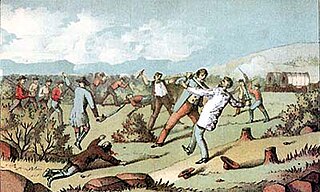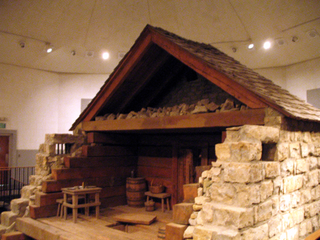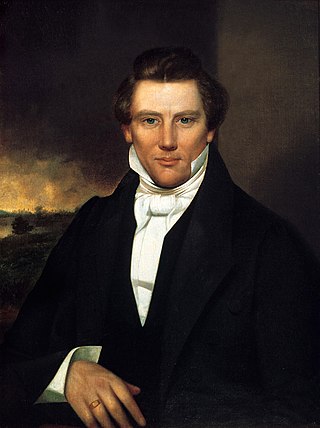Related Research Articles

David Rice Atchison was a mid-19th-century Democratic United States Senator from Missouri. He served as president pro tempore of the United States Senate for six years. Atchison served as a major general in the Missouri State Militia in 1838 during Missouri's Mormon War and as a Confederate brigadier general during the American Civil War under Major General Sterling Price in the Missouri Home Guard. Some of Atchison's associates claimed that for 24 hours—Sunday, March 4, 1849, through noon on Monday—he may have been acting president of the United States. This belief, however, is dismissed by most scholars.

Sidney Rigdon was a leader during the early history of the Latter Day Saint movement.

The Danites were a fraternal organization founded by Latter Day Saint members in June 1838, in the town of Far West, Caldwell County, Missouri. During their period of organization in Missouri, the Danites operated as a vigilante group and took a central role in the events of the 1838 Mormon War. They remained an important part of Mormon and non-Mormon folklore, polemics, and propaganda for the remainder of the 19th century, waning in ideological prominence after Utah gained statehood. Notwithstanding public excommunications of Danite leaders by the Church and both public and private statements from Joseph Smith referring to the band as being both evil in nature and a "secret combination", the nature and scope of the organization and the degree to which it was officially connected to the Church of Christ are not agreed between historians. Early in the group's existence, Joseph Smith appeared to endorse its actions, but later turned against it as violence increased and the actions of the Danites inspired a hysteria in Missouri that eventually led to the Extermination Order. According to an essay on the website of the Church of Jesus Christ of Latter-day Saints, "Historians generally concur that Joseph Smith approved of the Danites but that he probably was not briefed on all their plans and likely did not sanction the full range of their activities."

The Church of Jesus Christ is an international Christian religious denomination headquartered in Monongahela, Pennsylvania, United States. The church is a Christian Restorationist church and accepts the Book of Mormon as scripture. The church considers itself the gospel restored, or the original church and good news as established by Jesus Christ in the New Testament, restored upon the earth. It also claims to be the spiritual successor to the Church of Christ, organized by Joseph Smith on April 6, 1830. The church sees Sidney Rigdon as Smith's rightful successor following the assassination of Smith because Rigdon was Smith's first counselor in the First Presidency. The church is not officially affiliated with any other church, organization or denomination.

Adam-ondi-Ahman is a historic site in Daviess County, Missouri, about five miles south of Jameson. It is located along the east bluffs above the Grand River. According to the teachings of The Church of Jesus Christ of Latter-day Saints, an Adam-ondi-Ahman, but not necessarily the site in Daviess County, Missouri, is the site where Adam and Eve lived after being expelled from the Garden of Eden. It teaches that the place will be a gathering spot for a meeting of the priesthood leadership, including prophets of all ages and other righteous people, prior to the Second Coming of Jesus Christ.

The 1838 Mormon War, also known as the Missouri Mormon War, was a conflict between Mormons and their neighbors in Missouri. Early in the third decade of the nineteenth century, members of the Church of Christ began to migrate into Jackson County, Missouri. Their religious and political beliefs and practices differed from those of their Missourian neighbors. This and their social and economic cohesiveness began to trigger tensions and episodes of vigilante violence.

The Mormon pioneers were members of the Church of Jesus Christ of Latter-day Saints, also known as Latter-day Saints, who migrated beginning in the mid-1840s until the late-1860s across the United States from the Midwest to the Salt Lake Valley in what is today the U.S. state of Utah. At the time of the planning of the exodus in 1846, the territory comprising present-day Utah was part of the Republic of Mexico, with which the U.S. soon went to war over a border dispute left unresolved after the annexation of Texas. The Salt Lake Valley became American territory as a result of the Treaty of Guadalupe Hidalgo, which ended the war.

Missouri Executive Order 44 was a state executive order issued by Missouri Governor Lilburn Boggs on October 27, 1838, in response to the Battle of Crooked River. The clash had been triggered when a state militia unit from Ray County seized several Mormon hostages from Caldwell County, and the subsequent attempt by the Mormons to rescue them.
David Whitmer was an early leader of the Latter Day Saint Movement and one of the Three Witnesses to the gold plates of the Book of Mormon. Whitmer later distanced himself from Joseph Smith and was excommunicated from the church in 1838, but continued to affirm his testimony of the Book of Mormon. He was the most interviewed Book of Mormon witness.
Thomas Baldwin Marsh was an early leader in the Latter-day Saint movement and an original member of the Quorum of the Twelve Apostles, who served as the quorum's first president in the Church of the Latter Day Saints from 1835 to 1838. He withdrew from the church in 1838, was excommunicated from it in 1839, and remained disaffected for almost 19 years. Marsh was rebaptized into the Church of Jesus Christ of Latter-day Saints in July 1857, but never again served in church leadership positions.

Liberty Jail is a historical jail in Liberty, Missouri, United States, which served as the county jail of Clay County, Missouri between December 1834 and 1853. The jail is known in Latter Day Saint movement due to the imprisonment of its founder, Joseph Smith, and some of his associates during the 1838 Mormon War.

The Battle of Crooked River was a skirmish that occurred on October 25, 1838, and was a major escalator of the 1838 Mormon War. A Mormon rescue party, led by David W. Patten, formed to free three Mormon captives taken from Caldwell County the day prior, clashed with a Ray County militia company commanded by Samuel Bogart southeast of Elmira, Missouri. Exaggerated reports of the battle led Missouri Governor Lilburn Boggs to issue Missouri executive order 44, resulting in the forced expulsion of the Mormons from the state.

The Hawn’s Mill Massacre occurred on October 30, 1838, when a mob/militia unit from Livingston County, Missouri, attacked a Mormon settlement in eastern Caldwell County, Missouri, after the Battle of Crooked River. By far the bloodiest event in the 1838 Mormon War in Missouri, it has long been remembered by the members of the Latter Day Saint movement. While the spelling "Haun" is common when referring to the massacre or the mill where it occurred, the mill's owner used the spelling "Hawn" in legal documents.

The salt sermon was an oration delivered on 17 June 1838 by Sidney Rigdon, then First Counselor in the First Presidency of the Church of Jesus Christ of Latter Day Saints, and frequent spokesman for Joseph Smith, the founder of the Latter Day Saint movement, against church dissenters, including Book of Mormon witnesses Oliver Cowdery, David Whitmer, and John Whitmer, and other leaders including W. W. Phelps. The Salt Sermon is often confused with Rigdon's July 4th oration.

William Wines Phelps was an American author, composer, politician, and early leader of the Latter Day Saint movement. He printed the first edition of the Book of Commandments that became a standard work of the church and wrote numerous hymns, some of which are included in the current version of the Church of Jesus Christ of Latter-day Saints' hymnal. He was at times both close to and at odds with church leadership. He testified against Joseph Smith, providing evidence that helped persuade authorities to arrest Smith. He was excommunicated three times and rejoined the church each time. He was a ghostwriter for Smith. Phelps was called by Smith to serve as assistant president of the church in Missouri and as a member of the Council of Fifty. After Smith's death, Phelps supported Brigham Young, who was the church's new president.

The life of Joseph Smith from 1838 to 1839, when he was 33–34 years old, covers a period beginning when Smith left Ohio in January 1838 until he left Missouri and moved to Nauvoo, Illinois in 1839.
The history of the Latter Day Saint movement includes numerous instances of violence committed both by and against adherents. Mormons faced significant persecution in the early 19th century, including instances of forced displacement and mob violence in Ohio, Missouri, and Illinois. Notably, the founder of Mormonism, Joseph Smith, was shot and killed alongside his brother, Hyrum Smith, in Carthage, Illinois in 1844, while Smith was in jail awaiting trial on charges of treason and inciting a riot.

Abraham Lincoln's Lyceum Address was delivered to the Young Men's Lyceum of Springfield, Illinois on January 27, 1838, titled "The Perpetuation of Our Political Institutions". In his speech, a 28-year-old Lincoln warned that mobs or people who disrespected U.S. laws and courts could destroy the United States. He went on to say the Constitution and rule of law in the United States should be "the political religion of the nation."

The campaign of Latter Day Saint movement founder Joseph Smith and his vice presidential running mate, Church of Jesus Christ of Latter Day Saints First Presidency first counselor Sidney Rigdon, took place in 1844. The United States presidential election of that year was scheduled for November 1 to December 4, but Smith was killed in Carthage, Illinois, on June 27. Smith was the first Latter Day Saint to seek the presidency, and the first American presidential candidate to be assassinated.

The Expulsion of Mormons from Jackson County, Missouri occurred in 1833 when Mormons were forcibly displaced from Jackson County, Missouri amidst escalating violence between Mormon residents and non-Mormon vigilantes.
References
- Stephen C. LeSueur, The 1838 Mormon War in Missouri, University of Missouri Press, 1990.
- Alexander L. Baugh, A Call to Arms: The 1838 Mormon Defense of Northern Missouri, BYU Studies, 2000.
